Mandalay

The centre of arid Upper Burma, Mandalay is the country's 2nd largest city and has approximately 1,2 million inhabitants. The restoration of the legendary “Burma Road” a few years ago (linking Mandalay via Lashio with Yunnan in southern China) made the city on the Ayeyarwady river a recent boom town. How different the situation in the year 1886 which saw the end of Burma's traditional dynastic society. Having defeated the Burmese a third and last time during their enduring hostilities, the British dethroned King Thibaw and exiled the unfortunate monarch and his entourage to India. Burma was off on its long and arduous journey through its Age of Colonialism – eventually to be reborn as Myanmar in our modern time. Numerous religious monuments bear testimony to Mandalay's royal past – the most important being the Mahamuni Temple, home of the famous Golden Buddha. Further highlights are the Shwenandaw Monastery with its abundant ornate teakwood carvings and gilded interiors, the huge Marble Buddha or the Kuthodaw Pagoda, called “biggest book on earth” due to its great number of stone slabs grazed with Buddhist sutras, the most important Mahamuni temple with a huge Buddha made of gold – all are of great cultural importance. Mandalay Hill affords the best view of the city, also revealing the shell of the former Royal Palace: behind sumptuous brick walls looms an empty space once home to the legendary “Crystal Palace” with its more than 100 teakwood buildings which went up in flames when bombs hit Burma during World War II. No doubt: The great tradition of Burma's arts and crafts is in Mandalay.
Pyin Oo Lwin
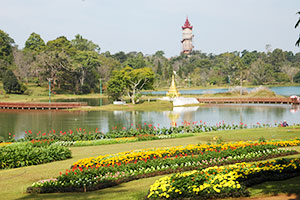
Pyin Oo Lwin or Maymyo is the most beautiful hill-station in Myanmar. It is situated on the edge of Shan Plateau. The town has 5 names; Maymyo, Pyin Oo Lwin (The Edge of Highland), Pann Myo (Flowers City), Nnin Myo (Snow City) and Taung Hlay Kharr Myo (Hill Stairs City). The British built the town because of its lovely situation in the high mountains.
The trace of British influence can still be seen although they retreated in 1948; The Stage Coaches, the Office Buildings and Private Houses in the British Style of Splendor, the trees and gardens and so on.
Things to see and visit in and around Pyin Oo Lwin now it is called: Pyi Chit Payar(The Marble Buddha Image that loves the nation), BE Waterfalls, Dat Taw Chaint Waterfalls, Peik Chin Myaung Waterfalls and Cave, Botanical Garden, Riding in one of the coaches to look around the town, the Tribal villages nearby the twon.
Try to taste the local coffee when you are there at the lovely hill-station. It is believed that the Myanmar local coffee has been cultivated there after the independence.
Why Maymyo should be visited?
- It is situated just at one and a half hour driving distance from the rich cultural city, Mandalay.
- Many nice and lovely hotels are there for staying overnihgt.
- Situated on the edge of Shan Hills, one can visit the town entering through the Chinese-Myanmar border town of Muse and Ruili(on China Side)
Amarapura
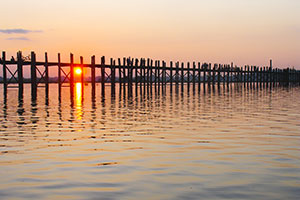
Another royal centre beyond the gates of Mandalay, Amarapura is known today for its stone works ranging from Buddha statues to trinkets, from works of art to trash as well as for its silk manufacturing. Several old pagodas and monasteries, mostly painted white – among others the Mahagandayon monastery with more than 1000 monks – provoke an enchanting atmosphere and remind us of its former importance. Another of Amarapura´s treasures is U Bein, the world´s longest teakwood bridge, partly made of ancient wood trunks taken from the long destroyed palace – especially at sundown a wonderful site for romantic photos.
Sagaing
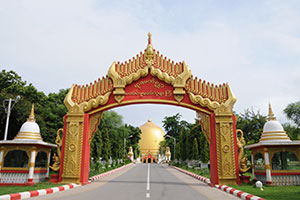
If one follows the road from Mandalay to Amarapura for a few kilometres, he comes across the town of Sagaing. Following the fall of the Bagan dynasty who lost the fight against the Mongols of the Khans about 700 years ago, Sagaing became the worldly and religious centre of the Shan people. Numerous pagodas and temples were built and used as centers of meditation, even to this day! The one and only (railroad-) bridge spanning the Ayeyarwady is to be seen shortly before entering Sagaing, a nice photo opportunity for many visitors (which is not cherished by the Burmese authorities!). The so-called look out-pagodas afford a lovely view of the pagodas at sunset.
Inwa / Ava
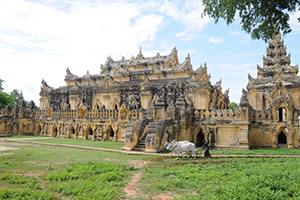
Today a Buddhist open air-museum, however, after the fall of Bagan 700 years ago Inwa – the former Ava (meaning “mouth of the lake”) – was Upper Burma's capital and has since undergone a sea of change. Inwa lies a few kilometers south of Amarapura near the Ava bridge. We cross the river Mytinge in a small boat and are expected – appropriately – on the other side by horse-drawn carriages for the short ride to the temples and wooden monasteries.
Mingun
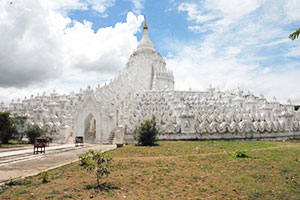
It takes only one hour by boat upstream the Ayeyarwady and we reach the imposing remnants of the largest Buddhist Pagoda ever built. Alas, the project was never completed. At the beginning of the 19th century, mighty King Bodawpaya decreed the building of the highest pagoda on earth. However, financial exhaustion as well as the lack of wood necessary for the production of bricks cut short his project. A mighty earthquake did the rest – it tumbled this memorial to religious hybris – yet the leftovers of the failed attempt at gigantism are impressive enough. They did, after all, succeed in casting the biggest sounding bronze bell on this planet! Of special attraction: the pagodas Settawaya and Myatheindan. Entering and leaving Mandalay harbour is always an opportunity for outstanding snapshots.
Monywa
This place is a must for the culture buff! It takes a little time to make this overnight excursion, but it is well worth the while. A 140 km drive in NW direction brings us to Monywa sprawling along the Chindwin River. En route: Visit of the pagodas of Thanbodday – a Hollywood fantasy specialist could have been godfather here – but see for yourself (without fail!). The true highlights of our Monywa excursion are the Buddhist cave temples of Powindaung, an artistic jewel among spiritually inspired building (wall paintings, Buddha galleries, rock carvings) dating back to the 14th till 16th centuries. Powingdaung takes its name from the alchemist U Powin who lived in this mountainous region hundreds of years ago. In order to reach the caves we have to cross the Chindwin river by boat, from there onward pickups take us on an approx. 1 hour's drive to the site. Make provisions for spending the night at Monywa. Bone fragments, traces of ancient settling and reaching way back to mankind ´s early days, have been found in the nearby mountains of Pontaung Ponnya. And for those aficionados of real trekking and elephant rides through monsoon forests, there is possibly another rewarding destination: the Alaundaw Kathapa National Park 100 km NW of Monywa.
Mogok
Welcome to “ruby country”! 200 kilometres N of Mandalay we reach Mogok and its world of rubies and sapphires. It is hard to imagine the drudgery of the migrant workers´ life as they attempt to wrest those precious stones from the womb of the earth. The Open-Air Ruby Market affords the pleasure of hunting for your own “lucky stone”. At the centre of town you will find Lake Mogok. The surrounding hills offer a marvellous view, especially of Chanthargyi Pagoda.


